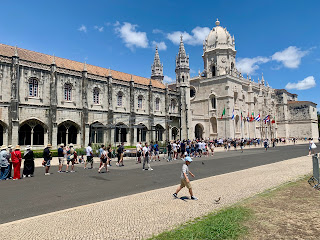17th - 18th Jul 2023
 |
| St. George's Castle, Lisbon |
Back in Lisbon, and I decided to take a wander (by tram) up the hill to St. George's Castle. On getting there I even decided to pay for a guided tour; not something I do often.
Left: Our guide ( the chap in the red shirt), and I've forgotten his name, something like 'Olé' I think. He was very charming and like most guides was keen to wax lyrical and enjoyed an audience to show off his wit and knowledge. He spoke good understandable English.
Right: A statue outside the castle of, I think, King Manuel 1 (1469 - 1521). There were a lot of peacocks around the place...no photos of them.
Apparently the castle was established in the 10th century by the Moors. The Portuguese and Christian armies eventually 'captured' it in 1147 by virtue of laying siege to it. The Moorish inhabitants just died off or ate each other. We were told to disregard all the info regarding the legendary Martim Mariz and his heroic attack. A myth, apparently.
Left: The front door. Originally there was a drawbridge, now replaced by the bridge you see here. Our guide spent ages (too long) posing us questions about how any attacking force could forcibly gain entry. There is a deep moat around the base, which in the old days, was filled with water and sewage. Our tour victims suggested battering rams, catapults, ballistics, trebuchets, ropes etc. etc. These were all discounted as impractical. Yours truly came up with the obvious idea of just buying a ticket at the ticket desk. This 'smart-arse' suggestion was not particularly well received. In fact the castle was never forcibly entered or 'stormed'. The Moorish inhabitants just died off under siege.
We were given a lot of blurb about things in the castle, such as what would happen if some enemy did invade it (which they didn't). One thing I learnt was that all narrow spiral staircases in old fortified buildings (and this is true worldwide) are constructed clockwise going up. This is because invaders would normally be right-handed and hold their weapon on the inside, and thus unable to use it effectively. Right: The passageway which runs all around the battlements. I walked around the entire top level.
Left: A view south over the city from one of the (re-enacted) gun positions (it never had any originally). This castle was actually reduced to rubble during the 1755 earthquake. What you see now is, basically, a magnificent reconstruction.
Right: A view of part of the 'reconstructed' outside walls.
Right: It was packed with a very raucous crowd.
I mentioned previously about the old Portuguese colonies and which, like Britain, has since attracted many ex-colonial natives to emigrate to their 'home' colonist's countries. I found it interesting to note that many, presumably Africans, still congregate as a group here in Lisbon. In this case (left) at Rossio Plaça there was a large gathering of Africans (I assume). Peoples, of whatever background, race and culture understandably tend to stick together.
Right: A grand statue of, I think, King João I, in Rossio Plaça. I have never seen a city with so many 'grand' statues!
Left: A very talented, tuneful and amusing group of girl students performing on Rua Augusta. They very jolly and obviously well rehearsed. Great fun to watch. I spoke to one of them who told me that they were economics students from university in Coimbra. I have a video of this, but cannot download it from my present location. I will do so when I get home. Worth watching.
They were interrupted in a part of their performance by a drunk wassock who staggered around in front of them, pretending to dance, drinking from a tin of beer. They carried on regardless. What a t@@t! I have a video of that also, but will publish when I can.
Left: The performers. There were two guitarists who were supremely skillful and played the most intricate music, seemingly effortlessly. Plus two singers; a man and a woman. It was a very jolly and entertaining performance. Again, video to follow when I get the opportunity back home. You will enjoy it!
Right: Downtown Lisbon with my new best friend.
Left: An amusing (mobile) Fado shop display. I'm not quite sure what they were selling.
Right: Another one of those 'living statue' performers. She stood rock-still without even blinking an eyelid despite people coming up and waving in her face...until someone put some money in her collection box. She then came to life and gave the donor a smile and a small flower. I think I've lost mine.
That is about all from me from Lisbon which is a most attractive and entertaining city. It is easy to get around town using the Metro and tram system, once you have sussed it out. I could have done much more, such as visit several museums but, largely through idleness, didn't. Off to Porto (or is it Oporto...not sure) next.




















































